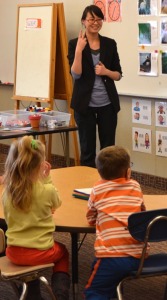EDITOR’S NOTE: We are pleased to announce the addition of reporter Nate Sunderland. He lives in Rexburg and will write about eastern Idaho public education news and features. This is his first installment of a two-part series examining foreign language immersion programs in eastern Idaho. The second is a feature on an elementary school at Fort Hall teaching young kids native languages.
RIGBY — By first or second grade, most American children have mastered the ability to ask and answer complex questions with complete sentences.
But hearing young American students pose and answer those same questions quickly, correctly and naturally in Mandarin Chinese, is more than a little impressive.

This linguistic feat is being achieved day by day at South Fork Elementary School in Rigby, where 155 kindergarten to second-graders — 23 percent of the school’s population — are learning Idaho curriculum in a foreign language.
“(Foreign language) helps these students. Their minds develop differently so they are able to learn subjects and topics differently,” Principal Richard Howard said. “It actually increases their ability to understand concepts, which carries over into their other studies.”
The concept, Howard said, is based on research that indicates children who learn foreign languages at an early age often exceed monolingual peers on assessments later in their academic careers.
Improving academic performance is one of several long-term goals Jefferson Joint School District 251 hopes to achieve with its Dual Language Immersion Program. The overarching goal is to create a generation of students with as many skills as possible to help them compete on the international stage.
Jefferson launched the program in 2013 for about 30 percent of its kindergartners and first-graders.
The program is based at two schools. At South Fork, students learn in Chinese for half the day and English for the remainder. Jefferson Elementary School students receive the same dual language instruction in Spanish.
The program is based on a similar language model developed at the Davis School District in Farmington, Utah. That district has successfully taught select elementary school students Chinese, French and Spanish for more than seven years.
The Jefferson program entered its second year in September. This year, the program has expanded into second grade to meet incoming immersion students.
“It’s harder,” 7-year-old Grace Barnes said. “But it’s fun because we’re getting to learn different things that we didn’t know … I can speak past 100 in Chinese now.”
Grace was among the first students to enroll in the program last year. Her parents and many others expressed significant interest in dual immersion when it was proposed.
The district launched the program with the stipulation it would only do so with financial support from interested parties. As a result, parents raised $45,159 in donations last year, covering the majority of costs associated with the launch.
But there has also been some trepidation among parents.
“There is a fear of the unknown,” Howard said. “A parent putting their child in a classroom where the student does not understand the language on the first day of school and coming home worried that they didn’t understand.”
It takes about two weeks for children to get used to program, he said. Language immersion teachers play a big role in helping students get comfortable with the new language.
Jefferson employees several native language teachers at both schools. First-grade teacher Yu Laoshi is one of three young educators brought from China to teach in Rigby.
“If you learn from a native, you learn not only the language, but also the culture,” Laoshi said. “For them it can expand their views and help them learn about a different world.”
The teacher-student exchange has been equally beneficial for Laoshi.
“I’ve learned a new system of education,” she said. “The students aren’t the same. Here they are more creative and in China the students are more disciplined … here you lead students to find their own way in learning. For me its been a challenge to think in an American way.”
Jefferson School District plans to continue expanding its program by a grade each year through May 2018, when the current immersion students reach middle school. The district then plans to develop a program for secondary students.
For the immediate future, the immersion program will continue to be paid mostly by donations. But the cost is expected to decrease significantly in the future, since its largest expense is the initial purchase of foreign language curriculum.
Eventually Jefferson plans to shift the primary financial burden back to the district, Program Director Michele Southwick said.
The success of Jefferson’s program is being noticed across the state. Last week, Jerome Joint School District 261 officials visited South Fork as part of an exploratory effort into starting a similar program. Jerome Superintendent Dale Layne said his district has been approached by interested parents.
“We’re taking a look to get a better understanding of how a dual immersion program works,” he said. “So far we’ve been very impressed with the teachers, the students and the behavior in the classroom.”
